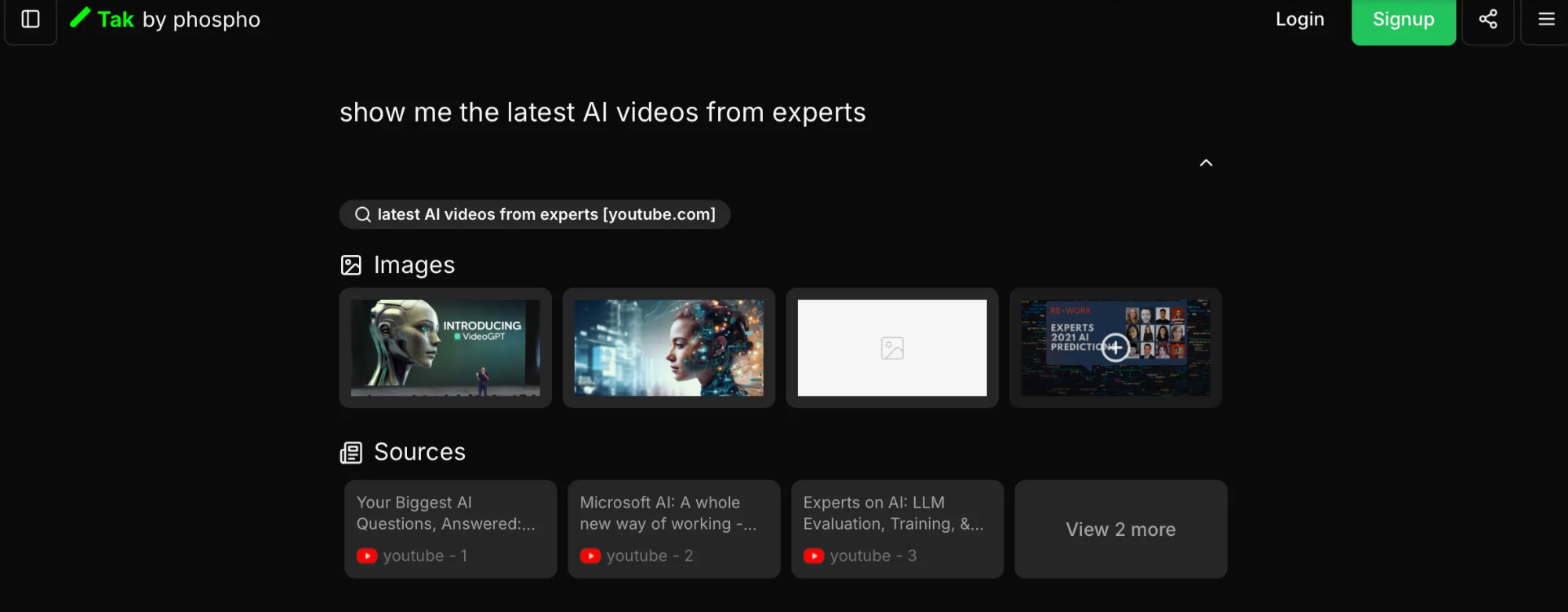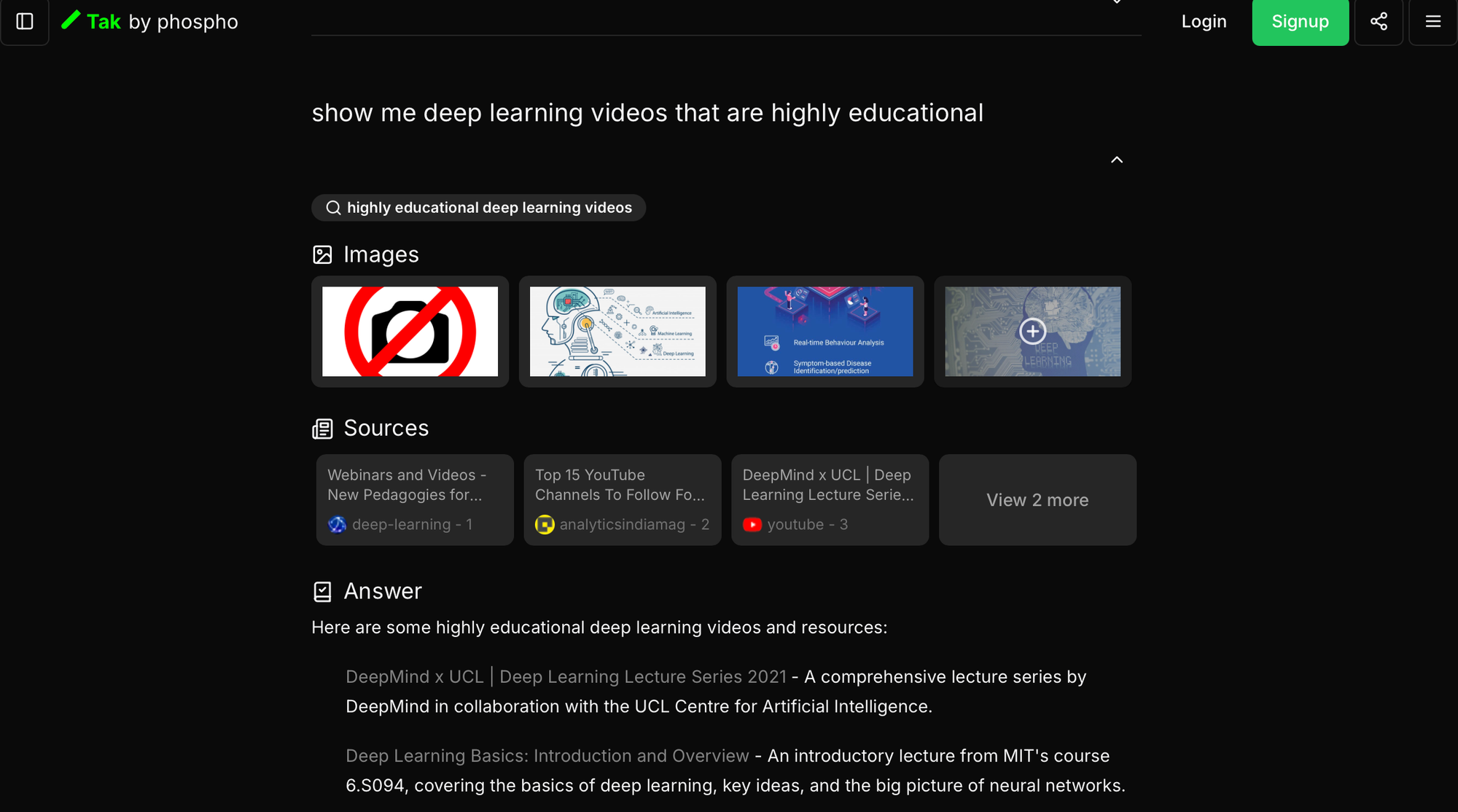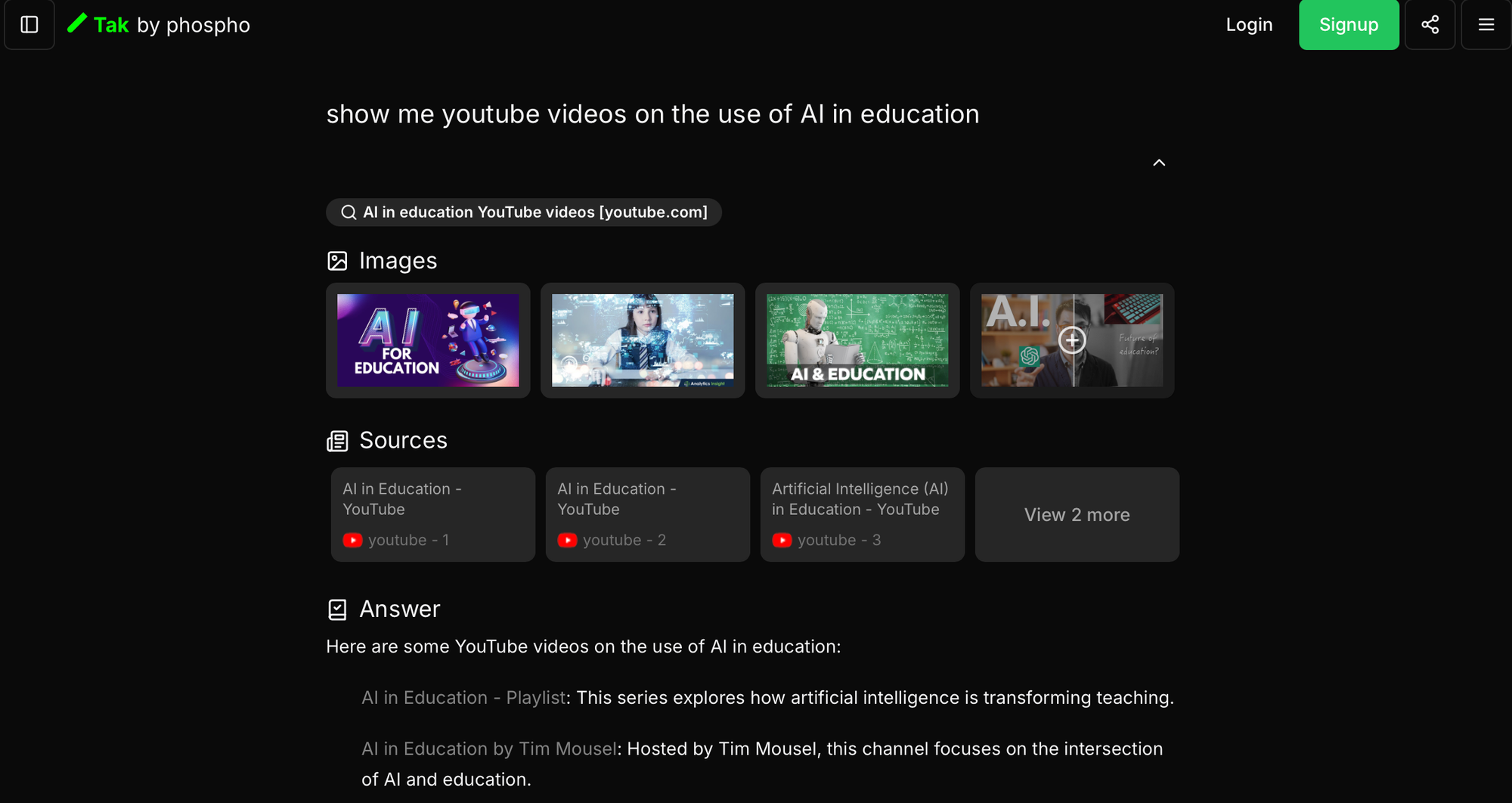Tak: The Easiest AI to Search for YouTube Videos
Tak by Phospho offers an AI-powered YouTube search engine that leverages NLP to provide accurate, intent-based video results, overcoming limitations of traditional keyword searches. It’s ideal for users looking for specific content and creators wanting better-targeted engagement.

Exciting news, phospho is now bringing brains to robots!
With phosphobot, you can control robots, collect data, fine-tune robotics AI models, and deploy them in real-time.
Check it out here: robots.phospho.ai.
Are you looking for an AI to search for YouTube videos? You might want to try Tak by Phospho.
YouTube is currently the most popular original video platform. Still, if you’re looking for a particular video – such as a how-to tutorial or an informational video – standard results from traditional search engines like Google (or even YouTube’s search function) can let you down.
This is because traditional search engines rely heavily on keywords and metadata while prioritizing engagement metrics for creators.
Video creators will often stuff keywords into meta tags or descriptions to game search algorithms and drive views, resulting in irrelevant, inaccurate results for the user. Particularly niche or highly educational content may not get a look in if it doesn’t appeal to the algorithm, no matter how high-quality the content is.
Luckily, an AI search engine like Tak by Phospho can save you time and prevent frustration by delivering much more relevant search results.
Why Use AI to Search for YouTube Videos?
Many people are now using AI to search for YouTube videos. This is because, unlike traditional search, AI search uses natural language processing to understand user intent and provide much more relevant results.
There are plenty of AI search platforms on the market right now (some might say too many!), but if you’re looking for a tool that’s particularly good at video search, Tak by Phospho is the best place to start – plus, it’s free.
Tak uses the most advanced and sophisticated AI models to match video content with user intent and preference, rather than purely matching keywords. The tool is part of Phospho’s ecosystem and provides a much more intelligent, accurate search experience that’s designed to deal with complex and nuanced user queries.
Complex video searches require more than just keyword matching – and viewers deserve better. It’s not unreasonable for us to expect an AI search engine to understand the intent and context behind our queries, and this is where Tak excels.
Tak by Phospho: Improving YouTube Search Accuracy with NLP
Using NLP (Natural Language Processing), Tak can analyze the context of your query and understand what it is you’re actually looking for, rather than just matching your keywords to the title and descriptions of popular videos.
For example, if you’re searching for videos on AI applications in healthcare that include real-world case studies, you’re likely to yield much more precise results when using an AI search engine like Tak, compared to YouTube’s in-built search function. This is because non-AI search prioritizes videos with high engagement, no matter how relevant they might be to what you’re looking for.
Not being able to find what you’re looking for on Google or YouTube is frustrating and makes you feel like you’ve wasted valuable time.
If you’re a content creator, you actually don’t want your users to rely on traditional search, as it causes more churn and may not lead viewers to watch your video unless they hit very specific metrics. This is backed up by data – various studies show that a large percentage of users (40-60%) abandon searches after finding irrelevant results in traditional search engines.
YouTube Vs Tak: Which is Better for Complex Queries?

Because YouTube search is built on keywords, it’s not very good at delivering context-heavy responses. Its search bar tends to prioritize trending content, keyword-heavy videos and channels that rank highly, which bury more relevant but lesser-known content.
Complex searches often require multiple search attempts on YouTube, with varying keyword phrases – and users still struggle to find what they need.
To demonstrate what we mean, typing ‘deep learning’ on YouTube may surface gaming-related content with the term ‘deep learning’ in the tags, which is frustrating if you’re looking to find academic or technical content.
By contrast, Tak’s NLP model can recognize the intent behind your search and deliver videos based on thematic analysis of the content itself, not just the title and meta description. In this way, zswTak goes beyond examining a few keywords and will evaluate the spoken language and captions in your video content to determine how relevant it is to the search query.
AI can dissect longer, more complex queries than traditional search, taking care to match the full context rather than just surface-level keywords. If a search query contains multiple descriptive elements or is particularly niche – for example, ‘latest blockchain applications in the financial sector explained by industry experts – Google won’t understand exactly what you’re looking for, it will only parse the keywords. Tak however, will deliver a much more relevant response because it excels at multi-layered queries.
In summary, using AI to search for YouTube videos can save you a lot of time and deliver the content you’re looking for, without you having to wade through irrelevant videos.
Why Tak is Better Than YouTube’s Search Bar: Self-Learning
There’s another reason why so many people use AI to search for YouTube videos — self-learning.
The more you use Tak, the better it becomes at understanding your unique preferences and will trailer results accordingly. This is because Tak uses machine learning to evolve search results over time-based on user interactions, refining suggestions more and more each time you use it.
Our self-learning function will improve the relevance of your future searches as the AI gets to know you. For example, you might search often for tech tutorials on a particular subject. The more you search for this content, the better Tak’s AI will become at prioritizing similar videos for you to watch in the future.
Our AI not only tracks search queries but also analyzes which videos you click on and how long you spend watching them. Over time, Tak learns more about your content consumption habits – for example, whether you like longer, in-depth tutorials, reviews, interviews or short clips – and will find them faster for you.
While it’s true that YouTube’s algorithm ‘learns’ over time, its recommendations are still primarily driven by what’s trending or currently going viral. In contrast, Tak’s recommendations are tailored to each user, focusing on specific interests and query complexity, giving you much more control over your search results.
For example, after a few quick searches about the use of AI in education, Tak will prioritize relevant and educational content over entertaining or trending videos that might not be relevant to what you’re looking for. This is great for creators and viewers alike, as Tak surfaces hidden gems and niche videos that may have lower views but still match the user’s search intent perfectly.

More tailored search suggestions also reduce the chance of content overload, making it easier to navigate the vast content library on YouTube and find exactly what you’re looking for.
With traditional search platforms, you can spend hours searching through dozens of videos to find what you want to watch. Tak’s AI updates and improves over time, ensuring the platform always delivers the most accurate and relevant videos based on user needs.
In other words, finding niche content becomes almost instantaneous, so you can spend less time scrolling and more time engrossed in engaging videos!
Tak is Revolutionizing YouTube Search with AI-Powered Accuracy
To sum up, many content consumers report that traditional, keyword-based search is just no longer cutting it. Search engines like Google and YouTube struggle to deliver results for complex or nuanced searches because they usually prioritize engagement over content relevance.
By contrast, Tak’s AI-driven Natural Language Processing (NLP) provides a much more user-friendly experience that prioritizes search intent. Its self-learning feature also improves over time, getting to know what kind of content you prefer so it can provide even more accurate and relevant content, with no extra effort from you.
Want to take AI to the next level?
At Phospho, we give brains to robots. We let you power any robot with advanced AI – control, collect data, fine-tune, and deploy seamlessly.
New to robotics? Start with our dev kit.
👉 Explore at robots.phospho.ai.
